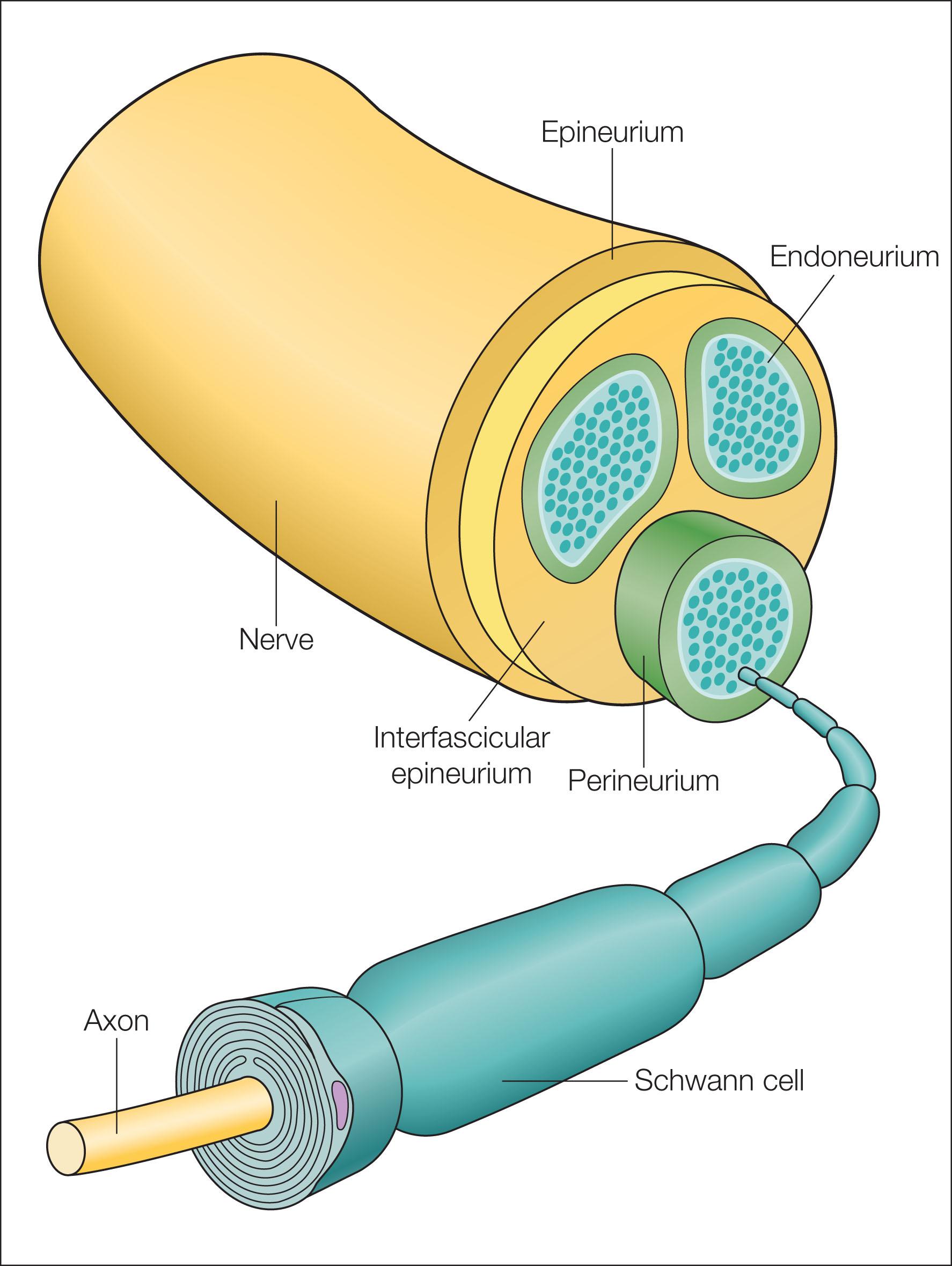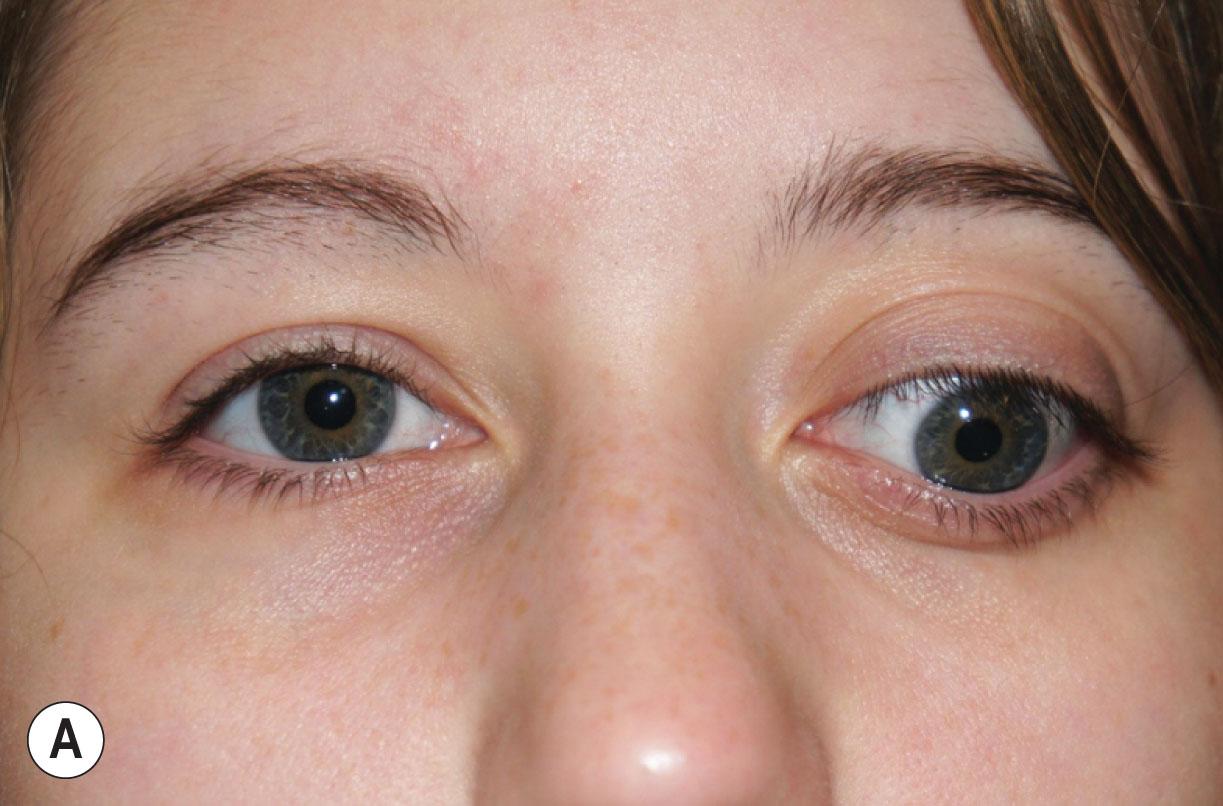Physical Address
304 North Cardinal St.
Dorchester Center, MA 02124
Primary neurogenic tumors of the orbit arise from the optic nerve, from peripheral sensory or motor nerves or from the autonomic ciliary ganglion. Secondary neurogenic tumors include retinoblastomas and intracranial meningiomas that invade directly from contiguous structures or neuroblastomas and peripheral neuroectodermal tumors (Ewing sarcoma) that spread hematogenously; these are discussed in other chapters.
The optic nerve (CN II) extends from the optic disc to the chiasm and is divided into four parts: the intraocular portion within the sclera, the intraorbital portion which pursues a sinuous course from the globe to the orbital apex, the intracanalicular portion within the narrow bony optic canal, and the intracranial portion from the canal to the chiasm. The nerve carries axonal bundles (95% retinal ganglion axons and 5% supportive astrocytes) and is surrounded by a pial sheath containing capillaries, the arachnoid layer, and a thick protective dural coat ( Fig. 21.1 ). The nerve is an extension of the central nervous system (CNS) and the myelin surrounding its axons is produced by CNS oligodendrocytes rather than by perineural Schwann cells as seen in peripheral nerves. Unlike peripheral nerves, it is not surrounded by neurilemma and so can't regenerate itself. Optic nerve gliomas arise from pial astrocytes within the substance of the nerve while primary optic nerve sheath meningiomas arise from cap cells of the arachnoid around the intraorbital or intracanalicular portion of the nerve.

The orbital peripheral nerves are either sensory branches of the trigeminal nerve (CN V) or motor branches innervating the extraocular muscles and eyelid retractors. These consist of bundles of axons, each of which is an extension of a single nerve cell and is surrounded by Schwann cells that myelinate the fibers to improve conductivity. The endoneurium is a loose matrix of collagen and extracellular matrix between the axons. Perineurium surrounds individual fascicles and the epineurium is the fibrous coating encasing the complete nerve which contains the blood supply (see Fig. 21.1 ). Common benign peripheral nerve sheath tumors include neurofibromas (proliferations of axons, fibroblasts, and Schwann cells) and schwannomas (composed predominantly of Schwann cells). Rare lesions include the perineurioma and malignant peripheral nerve sheath tumors.
The ciliary ganglion lies just temporal to the optic nerve, 1 cm behind the globe, and houses the parasympathetic short ciliary cell bodies. Rarely, a tumor arises from non-chromaffin tissue around the ganglion and ciliary nerves, termed the paraganglioma.
These primary orbital neurogenic tumors will be described individually.
Orbital neurogenic tumors differ between the pediatric and adult population in incidence and behavior. The optic nerve glioma is the most common neurogenic tumor in children and is relatively benign when isolated to the orbit. Conversely, the adult form is rare and often aggressive. Neurofibromas are the next most common lesion in children and are often plexiform neurofibromas associated with neurofibromatosis (NF) 1 (see below); these may rarely transform into a malignant variant after adolescence. Adult-onset neurofibromas are rare and typically are solitary, benign lesions. Primary optic nerve sheath meningiomas are more common in adults and tend to be relatively indolent sporadic lesions, whereas in children they are more aggressive lesions often associated with NF2.
Most pediatric neurogenic tumors may be associated with one of the seven neurofibromatoses (see also Chapter 69 ). These syndromes are caused by specific gene mutations and are characterized by various cutaneous pigmentary disorders, and peripheral or central nervous system benign and malignant neurogenic tumors. They are discussed in detail in Chapter 35 , but features of the three most common variants, NF1, NF2, and schwannomatosis, are summarized here:
NF1 (von Recklinghausen's disease) is an autosomal dominant genetic disorder occurring in 1 in 2600 births and is due to a mutation in the NF1 gene at chromosome 17q11 which codes for a tumor suppressor protein. Cutaneous and ocular lesions are the first manifestations and include multiple café-au-lait macules, axillary freckles, iris Lisch nodules, and neurofibromas. Sphenoid wing bone anomalies and optic pathway gliomas (occurring in 15% of NF1 patients) appear by the age of 3 years. Malignant transformation of tumors may occur in late adolescence or adulthood.
NF2 is a much rarer (incidence approximately 1:25,000 births) autosomal dominant genetic disorder caused by abnormalities in the NF2 gene on chromosome 22; this gene produces merlin, another tumor suppressor protein, and affected individuals are predisposed to various nervous system neoplasias including bilateral vestibular schwannomas, intracranial and optic nerve sheath meningiomas, and spine tumors.
Schwannomatosis is the third most common form of neurofibromatosis and presents in late adolescence and early adulthood with painful, recurrent schwannomas in peripheral nerves throughout the spine and body, but in the absence of bilateral vestibular schwannomas.
Optic pathway gliomas (OPG) are pilocytic astrocytomas arising from astrocytes within the optic nerve or its surrounding pial layer. Anterior OPG involve the intraorbital or intracanalicular optic nerve while posterior OPG involve the chiasm or post-chiasmal radiations near the hypothalamus.
Although some have suggested these are hamartomas based on their benign behavior, most consider them as neoplasia as they are histologically indistinguishable from other intracranial pilocytic astrocytomas, they can behave aggressively, and sporadic tumors have identified BRAF-IKAA and other chromosomal deletions associated with tumor suppression genes.
Optic pathway gliomas comprise 2% of cerebral gliomas. They occur primarily in children, with 90% identified before the age of 20. Thirty percent are associated with NF1 and usually appear early in childhood involving the anterior pathway. A small number are associated with NF2, but most occur sporadically.
Orbital optic nerve gliomas are slow-growing masses typically presenting in early childhood with proptosis or globe displacement, often first noticed by the parents or relatives. Strabismus and restriction in ocular ductions (particularly upgaze) may develop with growth of the tumor ( Fig. 21.2A ). Decreased central, color, and peripheral vision may be detected at presentation ( Fig. 21.2B ) and often deteriorate over time with growth of the tumor and gradual compression of the nerve or its blood supply. The child may be aware of double vision but is often not as bothered by the loss of visual acuity. Occasionally corneal exposure or pressure on sensory nerves may cause discomfort or pain. Optic nerve edema and later pallor may develop with ensuing optic atrophy.

Posterior pathway gliomas have no orbital findings, but present with visual disturbances with bitemporal visual field defects for chiasmal lesions or homonymous field loss for post-chiasmal lesions. Precocious puberty may develop in over a third of children with NF1-associated chiasmal gliomas. Sporadic cases of posterior OPGs tend to present more with raised intracranial pressure and obstructive hydrocephalus.
CT scans identify tubular optic nerve enlargement along the orbital portion of an optic nerve glioma, often with a characteristic kink or bend at the junction of the tumor with normal nerve. Calcification within the tumor is considered to be evidence of slow growth and a lower grade histology. Clear zones within the tumor mass may be areas of cystic degeneration.
Bone erosion or remodeling within the optic canal may indicate presence or invasiveness of the glioma and are best seen with CT. Suprasellar tumors may extend into the optic nerves or posteriorly into the optic tracts.
MR scans are best suited to identify the extent of spread of tumor along the optic nerve or tracts and help delineate involvement of surrounding intracranial tissues, including the hypothalamus ( Fig. 21.2B–C ).
Assessment of visual fields, ideally using the Goldmann apparatus, is useful for identifying any change associated with these tumors ( Fig. 21.2D ).
An OCT scan identifies retinal nerve fibre layer thinning correlated with visual deterioration and disease progression. Handheld OCT devices may be used for uncooperative children younger than 5 years.
The differential diagnosis for pediatric orbital optic nerve masses includes primary optic nerve sheath meningiomas and optic nerve sarcoidosis and leukemic infiltrates. Optic nerve meningiomas may have a more exophytic growth pattern and a more aggressive growth pattern in children. Their primary association with NF2 rather than NF1 may help in their differentiation. Optic nerve sarcoidosis is rare in children, appears as a more exophytic mass radiologically, and may be associated with elevated serum angiotensin-converting enzymes or hilar adenopathy identified on chest X-ray or CT scans. Leukemic infiltrates of the optic nerve are typically seen in recurrent disease since the brain is a sanctuary site after primary treatment; blood counts and lumbar puncture may help to secure this disgnosis.
The differential diagnosis for suprasellar masses includes craniopharyngioma, germinoma, sarcoidosis, and lymphoma. If MRI scan does not show evidence of optic nerve or tract involvement, these other choices are more likely than glioma, and biopsy is recommended.
In most cases, management is decided through consensus of a multidisciplinary team including the ophthalmologist, pediatric oncologist, radiologist, radiation oncologist, and neurosurgeon.
Optic nerve gliomas restricted to the orbit are best observed with serial ocular examinations (checking for pain, visual disruption, cosmetic concerns, visual deterioration, corneal exposure, or strabismus). Serial MR scans allow monitoring of tumor growth with particular attention to the speed of growth and extension intracranially. The intervals between checks depends on the association with NF1 (these tend to progress slower than sporadic cases), proximity to the optic canal or chiasm, and the documented growth rate.
Chemotherapy may be considered for progressive cases where vision remains good and the globe is not excessively displaced or exposed. Various combination therapies are available, including cycles every 3 weeks with vincristine with carboplatin or cisplatin. Single therapy with vinblastine has also been described. This may delay progression of disease for several years, particularly in NF1-associated gliomas.
Targeted medical therapies include MAPK/ERK (MEK) pathway inhibitors such as trametinib which has shown promise in phase 2 trials as single-agent treatment for progressive or refractory optic nerve gliomas. . Case reports have also shown promising results for BRAF-V600E inhibitor therapy with vemurafenib and anti-VEGF bevacizumab monoclonal antibody in reversing visual decline associated with advanced optic nerve gliomas.
Radiotherapy is avoided in patients with NF1 because of the risk of inducing malignant transformation of preexisting peripheral nerve sheath tumors or new-onset rhabdomyosarcomas. It may be employed for progressive sporadic optic nerve gliomas that have failed chemotherapy to avoid or delay surgery.
Surgical excision of the optic nerve is the definitive treatment for optic nerve gliomas that are expanding in size with poor vision and significant cosmetic concerns or pain from nerve compression or corneal breakdown. This is typically performed by an orbital surgeon and pediatric neurosurgeon through a combined craniotomy and orbitotomy, with resection of the optic nerve from the back of the globe to the chiasm ( Fig. 21.2E–F ). A small portion of the nerve anterior to the chiasm may be spared to prevent a visual field defect on the opposite eye from Wilbrand knee. Complications of surgery include transient or permanent facial nerve palsy (from the craniotomy) or oculomotor or trochlear palsy from the orbital resection.
These lesions carry a worse prognosis and are more commonly seen in adults and non-NF1 patients.
Observation may be considered initially for younger patients with NF1 as these tumors are more likely slower growing.
Surgery is indicated in cases of obstructive hydrocephalus with possible tumor resection and shunting.
Chemotherapy is offered in younger children to delay or avoid the cognitive and endocrine side effects associated with radiotherapy around the chiasm.
Radiotherapy has shown efficacy at shrinking chiasmal OPGs, reducing obstructive hydrocephalus, improving vision and delaying recurrences. In children less than 5 years old, it carries significant morbidity from cognitive impairment and endocrine disruption. Stereotactic radiotherapy and proton beam therapy may improve accuracy of treatment with fewer side effects.
Become a Clinical Tree membership for Full access and enjoy Unlimited articles
If you are a member. Log in here